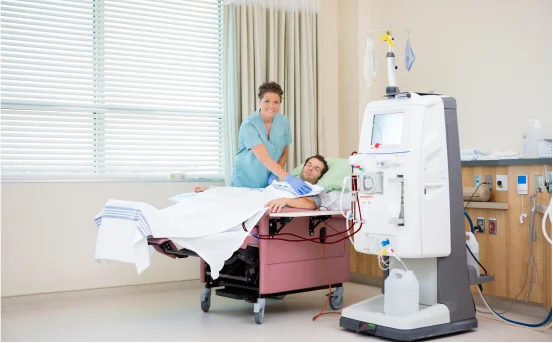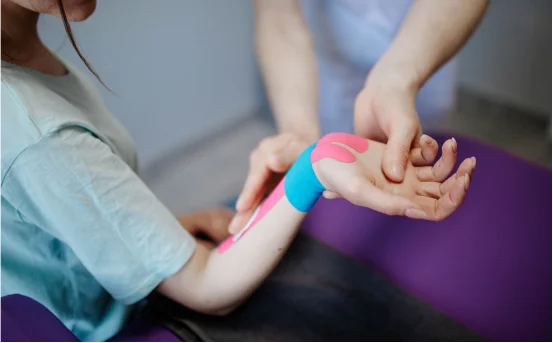Treatment of Dialysis is a life-saving medical treatment for individuals with chronic kidney disease (CKD) or kidney failure. When kidneys lose their ability to filter waste and excess fluids from the blood, dialysis steps in to perform this essential function.
Kidneys are vital organs that play a crucial role in maintaining your overall health. They filter waste products, remove excess fluids, balance electrolytes, and help regulate blood pressure. However, when your kidneys become damaged or lose their ability to function properly due to chronic kidney disease (CKD) or other medical conditions, harmful toxins and fluids start to accumulate in your body. This is where dialysis becomes a life-saving treatment.
What is Dialysis?
Dialysis is a medical procedure that artificially removes waste products and excess fluids from the blood when the kidneys can no longer perform this function effectively. It is often required for patients with end-stage renal disease (ESRD), where kidney function drops below 10–15% of normal.
The two main functions of dialysis are :-
-
Removing waste and toxins from the bloodstream
-
Balancing electrolytes and fluid levels in the body
Who Needs Dialysis?
Dialysis is recommended when a person’s kidneys are functioning at only 10–15% of their normal capacity. Common reasons include :-
-
Chronic Kidney Disease (CKD)
-
Acute Kidney Injury
-
End-Stage Renal Disease (ESRD)
-
Severe high blood pressure
-
Diabetes-related kidney damage
Signs that dialysis may be needed include :-
-
Swelling in the legs, ankles, or feet
-
Shortness of breath
-
Nausea or vomiting
-
Confusion or fatigue
-
Reduced urine output
Treatment of dialysis
There are two main treatment of dialysis: Hemodialysis and Peritoneal Dialysis.
Hemodialysis
Hemodialysis uses a machine and a filter called a dialyzer to clean the blood. The patient’s blood is pumped through the dialyzer, where waste and excess fluids are removed before being returned to the body.
-
Procedure :- Typically done 3 times a week at a dialysis center.
-
Duration :- Each session lasts about 3 to 5 hours.
-
Access :- Blood is drawn through a vascular access point, usually in the arm.
Home Hemodialysis is also an option for some patients, offering flexibility and convenience.
Peritoneal Dialysis
This type uses the lining of the abdomen (peritoneum) as a filter to clean the blood.
-
Procedure :- A cleansing fluid called dialysate is introduced into the abdominal cavity through a catheter. Waste products pass from the blood vessels in the peritoneum into the dialysate, which is then drained away.
-
Types :-
-
Continuous Ambulatory Peritoneal Dialysis (CAPD) :- Done manually several times a day.
-
Automated Peritoneal Dialysis (APD) :- Uses a machine overnight while the patient sleeps.
-
Choosing the Right Type of Dialysis
Several factors determine the most suitable dialysis method for a patient, including :-
-
Age and overall health
-
Lifestyle and daily routine
-
Access to a dialysis center
-
Personal preferences
-
Medical advice from nephrologists
Many patients start with hemodialysis and later switch to peritoneal dialysis or vice versa, depending on their evolving needs.
The Dialysis Procedure: What to Expect?
Here’s a general overview of what happens during a dialysis session :-
For Hemodialysis :-
-
Preparation :- Vascular access (fistula, graft, or catheter) is cleaned.
-
Connection :- Needles are inserted into the access point to connect to the dialyzer.
-
Blood Cleaning :- Blood is pumped through the dialyzer where waste is filtered.
-
Monitoring :- Vitals are checked throughout the process.
-
Post-Procedure :- Needles are removed, and you’re free to go.
For Peritoneal Dialysis :-
-
Catheter Insertion :- A catheter is surgically placed in the abdomen.
-
Dialysate Infusion :- The cleansing fluid is introduced.
-
Dwell Time :- The fluid stays in the abdomen, collecting waste.
-
Drainage :- Used fluid is drained and replaced.
Risks and Complications of Dialysis
While dialysis is generally safe and effective, there are potential risks and complications associated with each type :-
Hemodialysis Risks :-
-
Low blood pressure
-
Muscle cramps
-
Infections at the access site
-
Blood clots
-
Anemia
Peritoneal Dialysis Risks :-
-
Peritonitis (infection of the abdominal lining)
-
Hernia
-
Catheter-related infections
-
Weight gain
Early detection and prompt medical care can help manage these risks effectively.
Life on Dialysis: Lifestyle Adjustments
Dialysis may require some lifestyle changes, but many patients continue to live active and fulfilling lives. Here are some tips :-
-
Dietary Modifications :- Limit sodium, potassium, and fluid intake. A renal dietitian can provide customized plans.
-
Medication Management :- Take prescribed medications regularly, including phosphate binders, vitamins, and antihypertensives.
-
Regular Monitoring :- Attend all dialysis sessions and lab checkups.
-
Emotional Support :- Coping with chronic illness can be challenging. Consider support groups or counseling.
Can Dialysis Be a Temporary Treatment?
In some cases, dialysis may be temporary, especially if the kidneys are expected to recover from an acute injury or illness. Once kidney function improves, dialysis can be discontinued.
However, for patients with end-stage kidney disease, dialysis is usually a lifelong treatment unless they undergo a kidney transplant.
Kidney Transplant vs Dialysis
A kidney transplant is often considered the best long-term solution for patients with ESRD. However, not everyone is eligible due to age, health conditions, or lack of a matching donor.
Pros of Kidney Transplant :-
-
No need for ongoing dialysis
-
Better quality of life
-
Fewer dietary restrictions
Cons :-
-
Waiting time for a donor
-
Lifelong immunosuppressant medications
-
Risk of organ rejection
Future of Dialysis: Innovations and Hope
Researchers are continually exploring ways to make dialysis more efficient and comfortable. Some promising developments include :-
-
Wearable artificial kidneys
-
Improved portable dialysis machines
-
Bioengineered kidney tissues
-
Regenerative medicine approaches
These advancements may soon revolutionize kidney care and improve outcomes for millions.
Conclusion
Dialysis is a crucial treatment that sustains life when kidneys fail. With the right information, support, and medical guidance, patients can manage dialysis effectively and maintain a good quality of life. If you or a loved one is facing kidney issues, consult a nephrologist early to understand your options and begin the right treatment at the right time.























